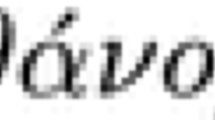Abstract
We introduce closed sets, which we will call knowledge units, to represent tight collections of experience, facts, or skills, etc. Associated with each knowledge unit is the notion of its generators consisting of those attributes which characterize it.
Using these closure concepts, we then provide a rigorous mathematical model of learning in terms of continuous transformations. We illustrate the behavior of transformations by means of closure lattices, and provide necessary and sufficient criteria for simple transformations to be continuous. By using a rigorous definition, one can derive necessary alternative properties of cognition which may be more easily observed in experimental situations.
Access this chapter
Tax calculation will be finalised at checkout
Purchases are for personal use only
Similar content being viewed by others
Notes
- 1.
This finiteness constraint can be relaxed somewhat, but there is relatively little yield for the resulting complexity.
- 2.
- 3.
Over 400 references can be found at the web site \(<\)cord.hockemeyer@uni-graz.at\(>\).
- 4.
Because U is discrete, there always is a “next” set above \(K_i\) in \(\mathcal{L}\), unless \(K_i = U\), the maximal element.
- 5.
In artificial intelligence (A.I.), learning is said to be “monotonic” if no new piece of information can invalidate any existing “knowledge” as represented by a set of rules. That concept of knowledge involves a notion of logical contradiction, not just the simple inclusion or deletion of experiential input. There is an abundance of literature about A.I. architectures which support both monotonic and non-monotonic reasoning [13, 17]. Our use of the term is rather different.
- 6.
A real function \(y = f(x)\) is said to be continuous if for any open set \(O_y\) containing y, there exists an open set \(O_x\) containing x such that \(f(O_x) \subseteq O_y = O_{f(x)}\), or using suffix notation \(x.O.f \subseteq y.f.O'\).
- 7.
Note that the \(\eta \) operator is normally neither expansive nor monotone.
References
Bernier, A., Beauchamp, M., Bourette-Turcot, A.-A., Carlson, S.M., Carrier, J.: Sleep and cognition in preschool years: specific links to executive functioning. Child Dev. 84(5), 1542–1553 (2013)
Caspard, N., Monjardet, B.: The lattices of closure systems, closure operators and implicational systems on a finite set: a survey. Discrete Appl. Math. 127(2), 241–269 (2003)
Cole, M., John-Steiner, V., Scribner, S., Souberman, E.: Mind in Society. Harvard University Press, Cambridge (1978)
Doignon, J.-P., Falmagne, J.-C.: Knowledge Spaces. Springer, Berlin (1999)
Ganter, B., Wille, R.: Formal Concept Analysis - Mathematical Foundations. Springer, Heidelberg (1999)
Gazzaniga, M.S., Ivry, R.B., Mangun, G.R., Steven, M.S.: Cognitive Neuroscience, The Biology of the Mind. W.W. Norton, New York (2009)
Granovetter, M.S.: The strength of weak ties. Am. J. Sociol. 78(6), 1360–1380 (1973)
Jamison, R.E., Pfaltz, J.L.: Closure spaces that are not uniquely generated. Discrete Appl. Math. 147, 69–79 (2005). also in Ordinal and Symbolic Data Analysis, OSDA 2000. Brussels, Belgium, July 2000
Ore, O.: Mappings of closure relations. Ann. Math. 47(1), 56–72 (1946)
Ore, O.: Theory of Graphs. Colloquium Publications, vol. XXXVIII. American Mathematical Society, Providence (1962)
Pfaltz, J., Šlapal, J.: Transformations of discrete closure systems. Acta Math. Hungar. 138(4), 386–405 (2013)
Pfaltz, J.L.: Closure lattices. Discrete Math. 154, 217–236 (1996)
Pfaltz, J.L.: Establishing logical rules from empirical data. Int. J. Artif. Intell. Tools 17(5), 985–1001 (2008)
Pfaltz, J.L.: Mathematical continuity in dynamic social networks. Soc. Netw. Anal. Min. (SNAM) 3(4), 863–872 (2013)
Pfaltz, J.L.: Mathematical evolution in discrete networks. Math. Appl. 2(2), 153–167 (2013)
Rosenfeld, A., Pfaltz, J.L.: Sequential operations in digital picture processing. J. ACM 13(4), 471–494 (1966)
Russell, S., Norvig, P.: Artificial Intelligence: A Modern Approach. Prentice Hall, Englewood Cliffs (2003)
Sarti, A., Citti, G., Petitot, J.: Functional geometry of the horizontal connectivity in the primary visual cortex. J. Physiol. (Paris) 103(1–2), 37–45 (2009)
Tononi, G., Cirelli, C.: Perchance to Prune. Sci. Am. 309(2), 34–39 (2013)
Šlapal, J.: Complete-lattice morphisms compatible with closure operators. Thai J. Math. 8(2), 255–262 (2010)
Šlapal, J.: On categories of ordered sets with a closure operator. Publicationes Mathematicae Debrecen 78(1), 61–69 (2011)
Author information
Authors and Affiliations
Corresponding author
Editor information
Editors and Affiliations
Rights and permissions
Copyright information
© 2016 Springer International Publishing Switzerland
About this paper
Cite this paper
Pfaltz, J.L. (2016). Using Closed Sets to Model Cognitive Behavior. In: Ray, T., Sarker, R., Li, X. (eds) Artificial Life and Computational Intelligence. ACALCI 2016. Lecture Notes in Computer Science(), vol 9592. Springer, Cham. https://doi.org/10.1007/978-3-319-28270-1_2
Download citation
DOI: https://doi.org/10.1007/978-3-319-28270-1_2
Published:
Publisher Name: Springer, Cham
Print ISBN: 978-3-319-28269-5
Online ISBN: 978-3-319-28270-1
eBook Packages: Computer ScienceComputer Science (R0)




